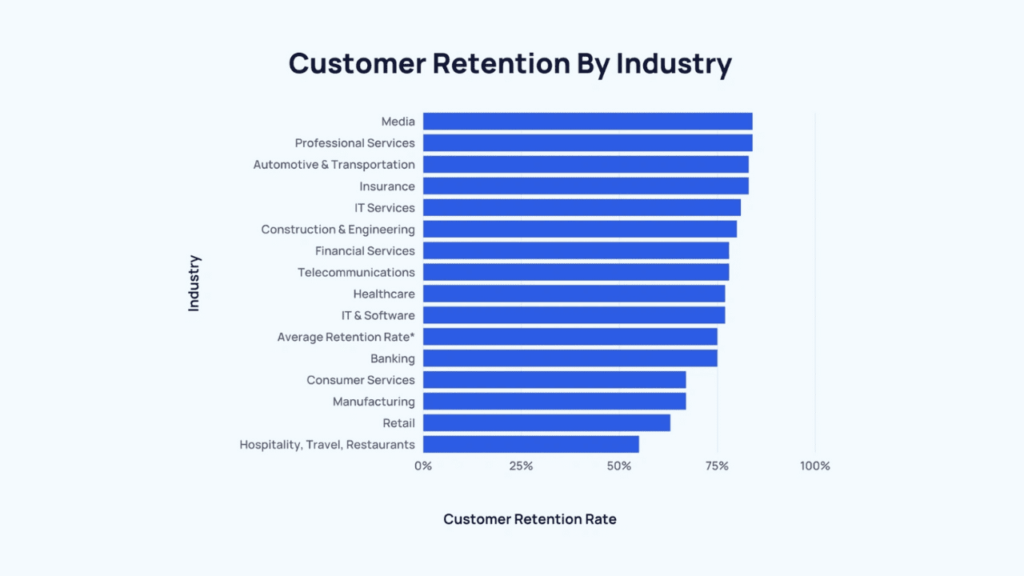AI-Driven Customer Retention Strategies in the Banking Industry
Imagine a large bank with millions of customers worldwide, constantly battling the challenge of retaining those customers and preventing them from switching to competitors. This bank used to rely on traditional methods for customer retention, which often involved sending generic marketing emails and offers to its customers, hoping some would stick. However, the results could have been more satisfactory.
Now, fast forward to the implementation of AI-driven customer retention strategies bolstered by the power of predictive analytics platforms. This bank harnessed the combined strength of AI and predictive analytics to transform its approach. It uses an AI-driven strategy that implements personalized recommendations, predictive churn modeling, 24/7 virtual assistants, fraud detection, customer feedback analysis, and so much more.
The result? The bank has witnessed a substantial increase in customer retention rates. Customers are more engaged, satisfied, and loyal, thanks to the personalized experiences and proactive measures provided by AI. Moreover, with a better understanding of customer preferences, the bank can cross-sell and upsell its financial products more effectively, boosting its revenue. So, let’s discuss: How is AI used in the banking industry? How can banks increase customer retention with the help of AI? And other important stuff. Stay tuned and keep reading.
Why is customer retention in banking so important for your business?
Interestingly, financial services and banking customer retention statistics reveal an encouraging trend. The average customer retention rate for financial services stands at an impressive 78%, while the banking industry maintains a slightly lower but still commendable rate of 75%. These figures reflect the effectiveness of retaining existing customers, showcasing a positive outlook for these sectors.

Customer retention is essential in every industry, and the financial sector is no exception. There are several compelling reasons why it holds such significance:
- Cost-effective: Acquiring new customers can be significantly more expensive than retaining existing ones. Banks can save on marketing and acquisition costs by retaining their current customer base. The average cost to acquire a new customer in the banking sector is around $500. This means they don’t start making a profit from a customer until well into the second year, highlighting the need for solid customer retention plans.
- Steady revenue stream: Long-term customers provide a stable source of income through the various services they use, such as savings accounts, loans, and credit cards.
- Cross-selling opportunities: Satisfied and loyal customers are more likely to engage in multiple banking services. This presents opportunities for cross-selling and upselling.
- Trust and loyalty: Retained customers are more likely to recommend the bank to others and have confidence in the institution.
- Data insights: The longer customers stay with a bank, the more data is collected about their financial behaviors and preferences. This data can be used to tailor services and offerings, improving the customer experience.
- Customer lifetime value: Retained customers have a higher customer lifetime value, as they contribute to revenue over an extended period. This is more economically advantageous than one-time transactions.
- Market reputation: High customer retention rates contribute to a positive market reputation. This attracts new customers who prefer a bank with a track record of customer satisfaction.
How is AI used in the banking industry?
AI offers numerous advantages for banking, like better customer experiences, lower operational costs and risks, and more effective fraud detection. This technology reshapes how banks operate and serve their customers. Now, let’s break down the ways AI is transforming the financial industry.
Chatbots and virtual assistants
Banks widely use AI-powered chatbots for customer interactions. When a customer has questions or needs help with something related to a bank account, he can chat with a banking chatbot instead of talking to a human on the phone. Chatbots in banking give answers or guide to the right information. This makes banking faster because a customer doesn’t have to wait on hold, and it’s available 24/7 to assist.
For example, Bank of America has a virtual assistant, Erica, who assists customers with various tasks like checking account balances, initiating transfers, and even addressing charge disputes. Thus, customers get a great user experience.
Robotic process automation (RPA)
Banks use Robotic Process Automation (RPA) to make their work more efficient. Imagine there are many tasks in the bank that are repetitive and involve doing the same thing repeatedly, like entering data or processing information. RPA in banking is like having helpful robots that can do these tasks quickly and without making mistakes.
As an example, Caixa Geral de Depósitos (CGD), a Portuguese bank, saved an impressive 370,000 work hours by the end of 2020, deployed RPA across 18 departments, and executed over 110 RPA initiatives. Robotics process automation in banking streamlined processes and catalyzed profound and sustainable changes within many departments. Notably, RPA allowed CGD to swiftly assist customers during the COVID-19 pandemic, automating over 60,000 communications and improving overall customer service.
Fraud detection and prevention
Fraud detection in banking involves sophisticated computer systems that continuously monitor transactions for any unusual or suspicious activity. These systems analyze spending patterns to detect deviations; if they spot something strange, they send alerts or even block the transaction. Also, when making online purchases, you may encounter added security measures like one-time codes sent to your phone, so there is no need to be irritated. This all exists to safeguard your finances. In essence, it’s like having a security team that keeps an eye on the safety of your money 24/7.
A Global bank uses AI and ML to combat check fraud. They aimed to identify counterfeit checks quickly and reduce the number of checks requiring manual review. By using a neural network model, historical check data, and comparative algorithms, they developed a real-time fraud detection system. As a result, the bank achieved a 50% reduction in fraudulent transactions, saved $20 million annually on fraud losses, and maintained a rapid response time, processing up to 1,200 checks per second.
Anti-Money Laundering (AML)
AML in banking is critical to combat illegal financial activities. AI plays a pivotal role by automating various AML compliance tasks. It continuously monitors and analyzes transactions, swiftly identifying any suspicious or unusual financial behavior. When AI detects such activities, it immediately raises red flags for further investigation, ensuring that the bank complies with strict anti-money laundering regulations.
Credit scoring
In banking, AI transforms the traditional credit scoring process. AI-driven credit scoring goes beyond conventional methods by analyzing a broader spectrum of data. It evaluates not only an applicant’s credit history but also factors in their online behavior, social media activity, and other non-traditional sources of information. By considering this diverse data, AI can more accurately assess an individual’s creditworthiness. This helps banks to make more informed and precise lending decisions, allowing them to offer loans to a broader range of customers, including those with limited credit histories.
Predictive analytics
Predictive analytics in banking refers to using data analysis and statistical algorithms to forecast future trends, behaviors, and events in the financial sector. It involves analyzing historical and real-time data to make informed predictions about various aspects, such as customer behavior, risk assessment, fraud detection, and market trends. By leveraging predictive analytics, banks make data-driven decisions, improve customer service, manage risks more effectively, and improve overall operational efficiency.
How can banks increase customer retention with the help of AI?
Numerous banks have always a question: how to retain customers in banking? In this case, AI brings transformative benefits to customers, profoundly impacting customer retention. Consider some of the advantages that AI offers to customers:
- Improvement of customer experience: Did you know that over the past year, 25% of customers switched their banks, and 39% of those people decided to switch primarily because they weren’t satisfied with the quality of customer service? To address this issue, it is really important to give customers high-quality support that’s available all the time and is quick and helpful. Using technology, like chatbots, can help a lot with this.
- Robust security: We all want to feel safe and secure. AI’s robust security measures effectively safeguard customers’ sensitive financial data, providing them with a sense of confidence and trust in their bank. When customers feel that their assets and information are secure, they are more likely to maintain their long-term relationship with the bank, as security is a top priority for retaining trust and loyalty.
- Personalized banking: AI empowers banks to offer customized financial advice that aligns with each customer’s individual goals and financial circumstances. This personalized approach not only helps customers achieve their financial objectives more effectively but also forges a deeper connection between them and the bank. As AI tailors service to each customer’s needs, it is pivotal in strengthening customer loyalty and improving their overall banking experience.
What are the future trends of AI in banking?
An increasing number of banks keep integrating AI into their systems. Remarkably, AI has the potential to yield savings of up to $447 billion for banks by the end of 2023, with the bulk of these savings, approximately $416 billion, originating from efficiencies in the front and middle offices. Research conducted by OpenText indicates that 80% of banks recognize these substantial savings opportunities and are actively incorporating AI solutions to improve customer retention. As multiple banks implement AI solutions, what will the future of AI in the financial sector look like?
First and foremost, AI-driven chatbots and virtual assistants will provide immediate, personalized money management solutions. They will use natural language processing (NLP) to understand and respond to customer inquiries, analyze emotions, and offer tailored financial advice based on individual financial history and goals. This aspect of banking will only continue to improve.
Next, high-performance computing will allow AI to automate and anticipate various money management solutions. This includes document processing, loan underwriting, and other currently labor-intensive and time-consuming processes. As a result, customers will receive their financial information more quickly.
Last but not least, AI is expected to deliver significant cost savings to banks. It will reduce operational costs, accelerate service delivery, and optimize decision-making processes.









